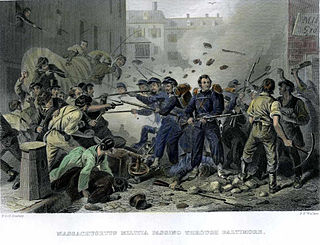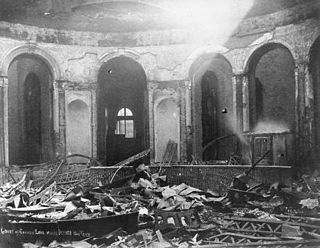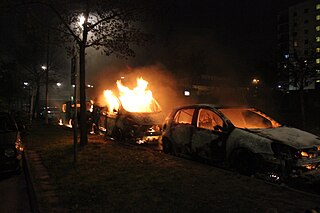Related Research Articles
In the broader context of racism in the United States, mass racial violence in the United States consists of ethnic conflicts and race riots, along with such events as:

The New York City draft riots, sometimes referred to as the Manhattan draft riots and known at the time as Draft Week, were violent disturbances in Lower Manhattan, widely regarded as the culmination of working-class discontent with new laws passed by Congress that year to draft men to fight in the ongoing American Civil War. The riots remain the largest civil and most racially charged urban disturbance in American history. According to Toby Joyce, the riot represented a "civil war" within the city's Irish community, in that "mostly Irish American rioters confronted police, [while] soldiers, and pro-war politicians ... were also to a considerable extent from the local Irish immigrant community."

The Baltimore riot of 1861 was a civil conflict on Friday, April 19, 1861, on Pratt Street, in Baltimore, Maryland. It occurred between antiwar "Copperhead" Democrats and other Southern/Confederate sympathizers on one side, and on the other, members of Massachusetts and Pennsylvania state militia regiments en route to the national capital at Washington who had been called up for federal service. The fighting began at the President Street Station, spreading throughout President Street and subsequently to Howard Street, where it ended at the Camden Street Station. The riot produced the first deaths of Union volunteers by hostile action, although caused by civilians, in the American Civil War. Civilians among the attackers also were killed.
The 2005 Macquarie Fields riots were a series of disturbances in south-west Sydney which occurred from 25 February 2005-1 March 2009. The Macquarie Fields riots were referred to as a riot by both the Parliament of New South Wales and the media.
Popular opposition to the American Civil War, which lasted from 1861 to 1865, was widespread. Although there had been many attempts at compromise prior to the outbreak of war, there were those who felt it could still be ended peacefully or did not believe it should have occurred in the first place. Opposition took the form of both those in the North who believed the South had the right to be independent and those in the South who wanted neither war nor a Union advance into the newly declared Confederate States of America.

The 7th Regiment of the New York Militia, aka the "Silk Stocking" regiment, was an infantry regiment in the Union Army during the American Civil War. Also known as the "Blue-Bloods" due to the disproportionate number of its members who were part of New York City's social elite, the 7th Militia was a pre-war New York Militia unit that was mustered into federal service for the Civil War.
The South Carolina civil disturbances of 1876 were a series of race riots and civil unrest related to the Democratic Party's political campaign to take back control from Republicans of the state legislature and governor's office through their paramilitary Red Shirts division. Part of their plan was to disrupt Republican political activity and suppress black voting, particularly in counties where populations of whites and blacks were close to equal. Former Confederate general Martin W. Gary's "Plan of the Campaign of 1876" gives the details of planned actions to accomplish this.

New York City during the American Civil War (1861–1865) was a bustling American city that provided a major source of troops, supplies, equipment and financing for the Union Army. Powerful New York politicians and newspaper editors helped shape public opinion toward the war effort and the policies of U.S. President Abraham Lincoln. The port of New York, a major entry point for immigrants, served as recruiting grounds for the Army. Irish-Americans and German-Americans participated in the war at a high rate.

The state of New York during the American Civil War was a major influence in national politics, the Union war effort, and the media coverage of the war. New York was the most populous state in the Union during the Civil War, and provided more troops to the U.S. army than any other state, as well as several significant military commanders and leaders. New York sent 400,000 men to the armed forces during the war. 22,000 soldiers died from combat wounds; 30,000 died from disease or accidents; 36 were executed. The state government spent $38 million on the war effort; counties, cities and towns spent another $111 million, especially for recruiting bonuses.

The Dead Rabbits riot was a two-day civil disturbance in New York City evolving from what was originally a small-scale street fight between members of the Dead Rabbits and the Bowery Boys into a citywide gang war, which occurred July 4–5, 1857. Taking advantage of the disorganized state of the city's police force—brought about by the conflict between the Municipal and Metropolitan police—the fighting spiraled into widespread looting and damage of property by gangsters and other criminals from all parts of the city. It is estimated that between 800 and 1,000 gang members took part in the riots, along with several hundred others who used the disturbance to loot the Bowery area. It was the largest disturbance since the Astor Place Riot in 1849 and the biggest scene of gang violence until the New York Draft Riots of 1863. Order was restored by the New York State Militia, supported by detachments of city police, under Major-General Charles W. Sandford.

The Memphis massacre of 1866 was a series of violent events that occurred from May 1 to 3, 1866 in Memphis, Tennessee. The racial violence was ignited by political and social racism following the American Civil War, in the early stages of Reconstruction. After a shooting altercation between white policemen and black veterans recently mustered out of the Union Army, mobs of white residents and policemen rampaged through black neighborhoods and the houses of freedmen, attacking and killing black soldiers and civilians and committing many acts of robbery and arson.

The Cincinnati riots of 1884, also known as the Cincinnati Courthouse riots, were caused by public outrage over the decision of a jury to return a verdict of manslaughter in what was seen as a clear case of murder. A mob in Cincinnati, Ohio, United States, attempted to find and lynch the perpetrator. In the violence that followed over the next few days, more than 50 people died and the courthouse was destroyed. It was one of the most destructive riots in American history.

The Cincinnati riots of 1841 occurred after a long drought had created widespread unemployment in Cincinnati, Ohio, United States. Over a period of several days in September 1841, unemployed whites attacked black residents who defended themselves. Many blacks were rounded up and held behind a cordon and then moved to the jail. According to the authorities, this was for their own protection.
Irish-American Catholics served on both sides of the American Civil War (1861–1865) as officers, volunteers and draftees. Immigration due to the Irish Great Famine (1845–1852) had provided many thousands of men as potential recruits although issues of race, religion, pacifism and personal allegiance created some resistance to service. A significant body of these veterans later used the military experience gained in the war to launch several conflicts with the goal of establishing an independent Irish Republic as members of the Irish Republican Brotherhood, the Fenian Brotherhood and Clan na Gael.

On 19 May 2013, violent disturbances broke out in Husby, a suburb dominated by immigrants and second-generation immigrant residents, including a substantial number from Somalia, Eritrea, Afghanistan and Iraq, in northern Stockholm, Sweden. The riots were reportedly in response to the shooting to death by police of an elderly man, reportedly a Portuguese expatriate, armed with a puukko knife, after entering his apartment and then allegedly trying to cover up the man's death.
The Leeds dripping riot was an act of civil disorder that occurred in Leeds, England on 22 February 1865. The riot was a response to the imprisonment of a local woman for the theft of dripping. During the riot one person was seriously injured and subsequently died while five people were arrested and charged with riotous conduct.

The 6th Regiment Massachusetts Volunteer Militia was a peacetime infantry regiment that was activated for federal service in the Union army for three separate terms during the American Civil War (1861-1865). The regiment gained notoriety as the first unit in the Union Army to suffer fatal casualties in action during the Civil War in the Baltimore Riot and the first militia unit to arrive in Washington D.C., in response to President Abraham Lincoln's initial call for 75,000 troops. Private Luther C. Ladd of the 6th Massachusetts is often referred to as the first Union soldier killed in action during the war.
The Cinderloo Uprising took place at Old Park in the Coalbrookdale Coalfield on 2 February 1821, when the South Shropshire Yeomanry confronted a crowd of 3,000 mostly striking workers who had gathered to protest the continued lowering of their pay.
A series of riots in loyalist areas of Northern Ireland began in Waterside, Derry, on 30 March 2021. After four nights of rioting in Derry, disturbances spread to south Belfast on 2 April, where a loyalist protest developed into a riot involving iron bars, bricks, masonry and petrol bombs. Following this, civil unrest spread to Newtownabbey on 3 April, where cars were hijacked and burnt, and petrol bombs were also used against police. Carrickfergus in southern County Antrim also saw serious civil unrest on the night of 4 April and morning of 5 April, where loyalists created roadblocks to keep police out of local estates and threw petrol bombs at police vehicles.
References
- ↑ "President Lincoln's Executive Order Authorizing a Draft".
- ↑ "In View of the Draft". Buffalo Morning Express. August 6, 1862.
- ↑ "SERIOUS RIOT OF DOCK LABORERS". Buffalo Morning Express. August 12, 1862.
- "RIOT IN BUFFALO. Strike of Irish and German Stevedores – The Police Force Overpowered – Final Arrest of the Ringleaders". The New York Times . August 13, 1862. Retrieved 2009-06-09.
A very serious disturbance occurred yesterday afternoon on the docks, caused by the Irish and German stevedores demanding increased pay for their work, and preventing others from working at the old rates.